22° halo
A 22° halo is an optical phenomenon that belongs to the family of ice-crystal halos. Its form is a ring with an apparent radius of approximately 22° around the Sun or Moon. When visible around the Moon, it is called a moon ring or winter halo. It forms as direct sunlight or moonlight is refracted in millions of hexagonal ice crystals suspended in the atmosphere.[1] The halo appears large; its radius is roughly the length of an outstretched hand at arm's length.[2] A 22° halo may be visible on as many as 100 days per year – much more frequently than rainbows.[3]
Formation
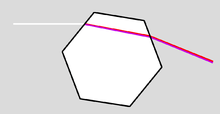

Even though it is one of the most common types of halo, the exact shape and orientation of the ice crystals responsible for the 22° halo are the topic of debate. Hexagonal, randomly oriented columns are usually put forward as the most likely candidate, but this explanation presents problems, such as the fact that the aerodynamic properties of such crystals leads them to be oriented horizontally rather than randomly. Alternative explanations include the involvement of clusters of bullet-shaped ice columns.[4][5]
As light passes through the 60° apex angle of the hexagonal ice prisms it is deflected twice resulting in deviation angles ranging from 22° to 50°. The angle of minimum deviation is almost 22° (or more specifically 21.84° on average; 21.54° for red light and 22.37° for blue light). This wavelength-dependent variation in refraction causes the inner edge of the circle to be reddish while the outer edge is bluish.
The ice crystals in the clouds all deviate the light similarly, but only the ones from the specific ring at 22 degrees contribute to the effect for an observer at a set distance. As no light is refracted at angles smaller than 22°, the sky is darker inside the halo.[6]
Another phenomenon resulting in a ring around the Sun or Moon—and therefore sometimes confused with the 22° halo—is the corona. Unlike the 22° halo, however, it is produced by water droplets instead of ice crystals and it is much smaller and more colorful.[2]
Weather relation
In folklore, moon rings are said to warn of approaching storms.[7] Like other ice halos, 22° halos appear when the sky is covered by thin cirrus or cirrostratus clouds that often come a few days before a large storm front.[8] However, the same clouds can also occur without any associated weather change, making a 22° halo unreliable as a sign of bad weather.
Image gallery
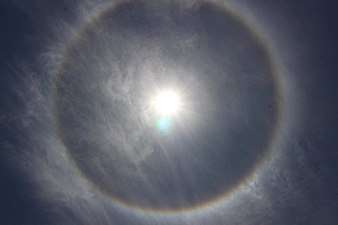 22° circular solar halo seen in Tarlac, Philippines on 28 April 2019
22° circular solar halo seen in Tarlac, Philippines on 28 April 2019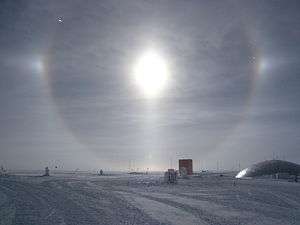 22° solar halo with parhelia and rare lower tangent arc at South Pole, 12 January 2009.
22° solar halo with parhelia and rare lower tangent arc at South Pole, 12 January 2009.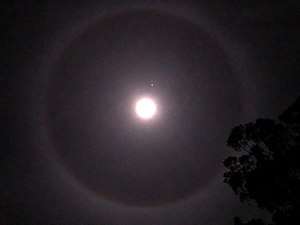 22° circular lunar halo - Springfield NSW - Australia - 27/05/18
22° circular lunar halo - Springfield NSW - Australia - 27/05/18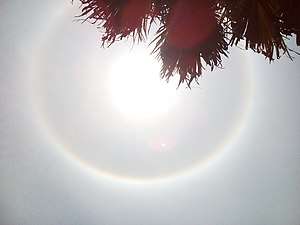 22° circular solar halo seen in Bangladesh, 19 March 2020.
22° circular solar halo seen in Bangladesh, 19 March 2020.
References
| Wikimedia Commons has media related to 22°-halo. |
- ""Disk with a hole" in the sky". atoptics.co.uk.
- Les Cowley. "22° Circular halo". Atmospheric Optics. Retrieved 2007-04-15.
- Pretor-Pinney, Gavin (2011). The Cloud Collector's Handbook. San Francisco: Chronicle Books. p. 120. ISBN 978-0-8118-7542-4.
- Tape, Walter; Moilanen, Jarmo. Atmospheric Halos and the Search for Angle x. Washington, DC: American Geophysical Union. p. 15. ISBN 0-87590-727-X.
- Cowley, Les (April 2016). "Bullet Rosettes & 22° Halos". Atmospheric Optics. Retrieved 2016-04-30.
- Les Cowley. "22° Halo Formation". Atmospheric Optics. Retrieved 2007-04-15. (Including excellent illustrations and animations.)
- "Why a halo around the sun or moon?". earthsky.org. EarthSky. Retrieved 3 August 2016.
Lunar halos are signs that storms are nearby.
- Harrison, Wayne (February 1, 2012). "Nelson: Ring Around Moon Sign Of Approaching Storm". The Denver Channel. Denver. TheDenverChannel.com. Archived from the original on February 3, 2012. Retrieved February 4, 2012.